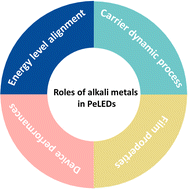Review on the promising roles of alkali metals toward highly efficient perovskite light-emitting diodes
Abstract
Perovskite light-emitting diodes (PeLEDs) have recently captured tremendous research attention owing to their outstanding semiconductor properties such as tunable bandgap, high defect tolerance, efficient carrier mobility and narrow emission line width. Significant developments have been made in PeLEDs, achieving an external quantum efficiency of over 20%. However, there is still a long way to go for commercial applications. Recently, alkali metals (Li+, Na+, K+, Rb+ and Cs+) have been used to obtain high-performance perovskite light-emitting diodes, presenting a thriving development trend. Herein, we comprehensively summarize the roles of alkali metals in the field of PeLEDs for better performance. The background and foundational concepts of PeLEDs are presented, and we discuss the introduction of alkali metals into PeLEDs as an effective strategy for adjusting energy level alignment, improving perovskite film properties and optimizing device performance. The incorporation of alkali metal ions into the charge transport layer is mentioned, which has been neglected in previous studies on PeLEDs. Several studies on high-performance PeLEDs based on alkali metals are also highlighted, and the challenges and perspectives are addressed.

- This article is part of the themed collections: Journal of Materials Chemistry C Recent Review Articles and 2023 Journal of Materials Chemistry C HOT Papers


 Please wait while we load your content...
Please wait while we load your content...